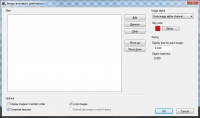Overview
The Image Animation object lets you create animations from a series of images.
An animation with images from the Image Animation object will use more memory than playing a video file, but on the other hand it will use much less CPU power during playback. It will also be quite easy to create animations with transparency this way, than otherwise encoding the animation into a normal video format with transparency support.
Preferences

Files
- List of images that will be used. They will be displayed from top to bottom by default.
Display images in a random order
- If enabled the image to be shown will be selected by random.
Loop images
- If the object is not adjusted to the total time of all images it is possible to loop the images. The object will start on the first image and then play the next one, and when the end is reached the object will start over from the first one again. This will continue for the length of the object that is set in the time line.
Extend last image to end of object
- If the object is not adjusted to the total time of all images it is possible to extend the last image in the list, this means that when the last image in the list is reached that image will stay visible until the end of the object length.
Compress textures
- If the graphic card supports compressed textures and this flag is enabled the image will be compressed in graphic card memory, this will make it more effective and enable the software to store more images in graphic card memory. If the graphic card does not support compressed textures the image will not be compressed.
 Note: The image is compressed using a lossy format, so the image may lose some quality.
Note: The image is compressed using a lossy format, so the image may lose some quality.
Image alpha
- Specify if or from where the Image Animation Object should fetch the alpha channel to be used with the images. The Image Animation Object supports transparent images in PSD (Photo Shop), TIFF and PNG. Using a key color will not give you as good result as using an alpha channel since only the selected color will be masked, often resulting in “jagged” edges.
Timing
- Display time of each image
- The duration for each of the images, this time will be multiplied with the total amount of images, to give the total duration of the object.
![]() Note: The image is compressed using a lossy format, so the image may lose some quality.
Note: The image is compressed using a lossy format, so the image may lose some quality.